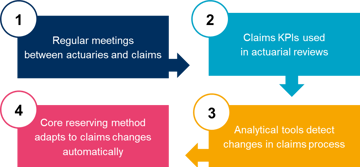Actuarial engagement with the Claims Function – what does good look like?

Covid-19 has the potential to disrupt claims development patterns, and the reserving projections which rely upon these, in an unprecedented way.
This article considers how insurers can strengthen the exchange of information between the Claims and Actuarial Functions, in particular in the area of case estimation.
The claims development pathway
The strength of interaction between claims and actuaries has been under the spotlight in recent years, both from internal management and regulators. An insurer whose reserving process responds intelligently to variations in claims handling activity can gain a competitive advantage by spotting trends more quickly.
At LCP’s reserving seminar, I suggested a “pathway” to help actuaries strengthen their links with the claims team and get the best out claims data.

Regular dialogue between actuarial and claims teams is critically important to provide actuaries with early warning of emerging risks or outdated assumptions. But it is not enough. These regular conversations should be seen as a building block, rather than the end state.
The ultimate goal is a reserving process that adapts to changes in claims handling, and in a reliable way. By addressing this key area of uncertainty in reserves, the business will be able to make decisions based on the reserves sooner and with greater confidence.
It will also be easier to make improvements to claims handling systems without wreaking havoc on the overall reserving process.
Keeping on top of case estimates
It is a fact of life that reserving actuaries treat case estimates as “data”, ie as something relatively factual that can be reliably used for modelling. However, even the most disciplined and objective case reserving approaches still require a lot of judgement from claims handlers.
That judgement can be influenced by various factors, many of which are unlikely to lead to “formal” changes in case estimating practices that claims teams might discuss with reserving actuaries. For example:
- Market cycles: Many analyses of historical data have demonstrated that case reserves tend to become weaker when times are tight for insurers, and vice versa. This has in turn caused insurers to understate or delay the recognition of bad news.
- Claims team management and resourcing: Most reserving actuaries can attest to observing disruption in case reserving practice when there are changes in management or resourcing constraints in the claims team. This is true even when the agreed case reserving policy is unchanged.
A good reserving actuary will be sceptical of any assertion from the claims team that “there have been no process or estimating philosophy changes”. An even better reserving actuary will understand that a claims teams operate in a dynamic environment and their judgements will be responding to changes in that environment every day.
Does a more structured approach to case estimation help actuaries?
Not necessarily. Adding more structure to the case reserving process might reduce the emphasis on handlers’ judgements, but it is not clear that this helps reserving actuaries in the long run.
Standard case reserves tend to suffer from “drift” over time as the business and the environment changes. There can be painful shocks to reserves when these are eventually updated. Highly structured case reserving systems can also be at greater risk of systematic over or understatement, which can be a bigger problem than inaccuracies in handlers’ individual judgements.
It’s often tempting to think of case reserving as “good” or “bad”, but from the reserving actuary’s point of view, it’s more important for case reserving to be consistent over time. Actuaries need to regularly assess this consistency and seek to understand changes in the claims team and the external environment that might affect it. This is a challenging task whether the case reserving is structured or left to the judgement of the claims handler.
Take-away thoughts
If your reserving function is still in the early stages of the claims development pathway, it’s worth using Covid-19 as a prompt to make some improvements. Disruptions to traditional reserving methods are likely to persist on many classes and actuaries will need to look to new and different datasets in order to keep pace with rapidly changing trends. Better claims analytics is changing from a “nice-to-have” to “must-have” for firms who aim to emerge stronger from Covid-19.

